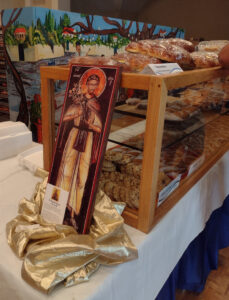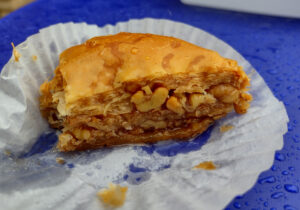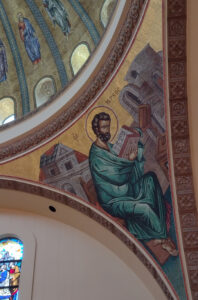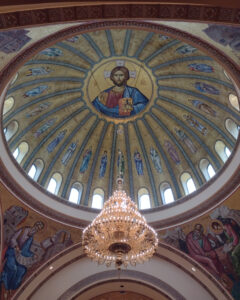Even the rain couldn’t keep the crowds from gathering in the Short North Arts District of Columbus. Thousands of red-clad football fans wandered the streets on their way to the OSU v. Notre Dame game over Labor Day weekend, but just three miles south, hundreds of others had a different—dare I say better—destination in mind: the 49th Annual Columbus Greek Festival.

For nearly half a century, the parishioners of the Annunciation Greek Orthodox Cathedral have held the Greek Festival in celebration of their religious and cultural Greek heritage. Food, music, jewelry, and the very architecture of the cathedral itself draw a crowd of roughly 40,000 each year.¹ And this rainy weekend was no different.
Arriving with an orthodox cross from my grandmother around my neck and a hat to keep the raindrops out of my eyes, I instantly knew my first destination in this Greek haven: Maria’s Pastry Shoppe. Trays of stringy kataifi pastries and honeyed melomakarona cookies were infinitely tempting. However, I had one thing and one thing only on my mind: baklava. Creating this delicacy is a time-consuming process. A dozen or so layers of thin pastry dough must be patiently laid over other layers of butter, pistachio, and dripping syrup. Eating baklava means appreciating the love and time the baker has dedicated to sharing this dessert.

And love and time has clearly been baked into the entire Greek Festival. A Deacon waved visitors into the museum of Greek culture and clothing; volunteers with name tags guided people to food stands; parishioners in traditional clothing wove their way through the crowds and sang enthusiastically; young men and women danced under the tent outside. But even amidst the cacophony, the hosts never forgot their sacred duties.

Vespers, taken from the Latin word for evening, is a service that closes the day and is commonly attended by many parishioners. In its current form as early as the sixth century, this service was conducted during sunset, which meant it usually occurred between the hours of three and six o’clock in the evening. It therefore avoided the need to light candles to illuminate the service. Vespers has a host of liturgical ancestors. The Jewish evening sacrifice in the Temple of Jerusalem served to conclude the day. And in the fourth century, another Office occurred as the sun set: the Office of the Lights. Held in the Church of the Holy Sepulchre in Jerusalem, a multitude of lights were lit so that an “infinite light” glowed within the church.² ³
I had arrived to the Vespers service late—the smells of the food line had finally won me over and I spent the first twenty minutes of the service devouring keftedes (spiced meatballs) and spanakopita (spinach, cheese, and herbs wrapped in buttered dough) in the courtyard.
Stepping into the nave of the cathedral under the electric lights of our modern day, I can only dream of how candlelight would have glittered across the mosaics covering much of the architecture. Italian Bruno Salvatori designed and installed the colored glass mosaics of the Annunciation in 1989. His artistic style reflects that of the Byzantines, with golden skies, warped architecture and perspective, and sharp clothing lines.


Each detail of the stunning cathedral serves to point the parishioner to sacred truths. Even as a worshiper sits and listens to the auditory banquet of Vespers, the candles in the narthex remind them of how the light of Christ softens the hard wax of the soul. Christ at the peak of the dome is at the helm of this ship, lifting those below into heaven. The altar faces east, towards the rising sun of Christ, and is elevated on steps to hover in heaven, between earth below and the universe above.
The Priest’s final prayer, or oratio is concludes the service. During the latter half of the service, he had remained beyond the gate and icon screen that separated the altar from the rest of the cathedral. He could be heard intermittently responding to the Reader’s and the Deacon’s chants from under the outstretched arms of the Virgin Mary mosaic decorating the half dome over the apse. Amplified by the wireless microphone, his voice carried over the icons and echoed in the cavernous cathedral under the gaze of Christ Pantocrator in the massive dome above.
But he had to return from heaven to earth. As the Priest left the apse, his chanting voice seemed suddenly to bound itself once more within his body, having completed its dance among the dazzling mosaics. Details piled on details. I looked down at the design of the orthodox cross around my neck, each part trying to point me to a sacred truth. On the grounds around the holy cathedral, the festival continued, each detail of the weekend lovingly layered in celebration of their God and their community.
¹ “Columbus Greek Festival 2022,” https://rove.me/to/ohio/columbus-greek-festival#:~:text=The%20festival%20attracts%20about%2040%2C000,Christian%20church%20and%20Greek%20culture.
² New Catholic Encyclopedia, Vol. 14, The Catholic University of America
³ The Catholic Encyclopedia, Vol. 15, The Encyclopedia Press, Inc.
Images by editor